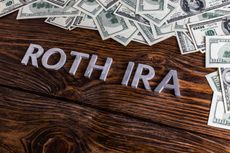Preserve Your Savings for Life
New ways to spread your nest egg over the next 30 years.

Editor's note: This article is adapted from Kiplinger's Retirement Planning 2008 guide. Order your copy today.
With the first wave of baby-boomers on the verge of retirement, there is escalating emphasis on helping retirees turn years of savings into a stream of income that they can't outlive. With more than $16 trillion in retirement savings nationwide, the stakes are high.
Retirees have traditionally relied on guaranteed lifetime income from pensions and Social Security. But these days, your retirement nest egg is more likely to be a lump sum -- either a one-time distribution from a pension plan or accumulated savings in a 401(k) or IRA. The challenge is to invest your money so it grows enough to last throughout what could be a 30-year retirement. In addition, you must figure out how much you can withdraw each year without running out of money.

Sign up for Kiplinger’s Free E-Newsletters
Profit and prosper with the best of expert advice on investing, taxes, retirement, personal finance and more - straight to your e-mail.
Profit and prosper with the best of expert advice - straight to your e-mail.
In effect, the challenge is to create your own pension. But luckily, the financial-services industry is stepping up to the plate with an array of new solutions.
"Retirement-income products are the next big thing," says Jim Peterson, vice-president of the Center for Financial Research at Charles Schwab. "We're going to see lots of new products with new twists." Although there's no single investment solution to manage all of your retirement income just yet, several new options can help you construct a plan that works for you.
Two mutual fund giants -- Fidelity Investments and the Vanguard Group -- recently unveiled a new class of funds that manage your assets and provide a retirement income stream. Meanwhile, the insurance industry is reworking immediate annuities to meet the demands of aging baby-boomers.
Maximize your payout
If you're looking for the maximum amount of income for a specific period of time, one of the 11 new Fidelity Income Replacement funds may be appropriate for a portion of your nest egg. You choose a mutual fund with a target date -- currently from 2016 to 2036 -- and receive monthly payments until that year, when the fund is exhausted. Your payments are set for one year at a time and can rise -- or fall -- in subsequent years, depending on market performance.
Because of the preset time frame, payouts from the Fidelity funds can be larger than the recommended withdrawal rates for retirees who have to stretch their money over a lifetime. Generally, retirees are encouraged to withdraw just 4% of their nest egg the first year, and to increase the dollar amount to adjust for inflation in subsequent years. So if you have $500,000, you would withdraw $20,000 the first year. Assuming 3% inflation, you would take out $20,600 the second year, and so on.
But money you invest in the Fidelity funds will be depleted by a preset date, so you don't want to put all of your savings in one of these funds. Instead, such a fund would work well as an income bridge or to cover specific spending needs, such as a travel budget. The longer your time horizon, the smaller your initial payout rate will be.
Say you're 55, work part-time and plan to collect Social Security at 65. You could use Fidelity's 2018 Income Replacement fund to supplement your income for the next ten years. The initial payout rate of the 2018 fund is 9.58%. So if you invested $200,000, you would receive $19,160 the first year, spread out over 12 monthly payments.
The payout rate would gradually increase to 100% of the fund's balance in the final year, but the actual dollar amount could fluctuate from year to year. For example, had the fund been available during the three-year bear market that started in 2000, your monthly payment would have dropped from $1,597 the first year to $1,412 by 2003, according to an analysis by Morningstar. If the market performs well, however, your payouts could increase each year.
Or say you and your spouse are both 65 and would like some added income to supplement your pension and Social Security benefits. If you invested $200,000 in the Fidelity 2026 Income Replacement fund, you would receive a 6.5% payout, or about $13,000, the first year, with the possibility of higher payouts in subsequent years until the assets were exhausted 18 years later.
But don't tie all of your assets to your life expectancy. Although the median life expectancy for a 65-year-old is 83, half of that age group will live longer. If you're one of them, you could be out of luck if your funds expire before you do.
Although the Fidelity Income Replacement funds don't offer guaranteed income for life, they offer plenty of flexibility. You can stop payments, switch funds to shorten or lengthen your payout schedule, or withdraw all your money at any time -- without paying a fee. "We've created a vehicle that allows you to change your plans on the fly," says Jonathan Shelon, co-manager of the funds.
[page break]
Balance income and growth
If you don't like the idea of mutual funds with an expiration date, take a look at Vanguard's new retirement-payout funds. They're designed to help retirees balance their current income needs against their desire for growth. "Our investors are very interested in having flexibility in later years to cover unexpected costs or to leave money to family members," says Ellen Rinaldi, head of retirement services for Vanguard.
Investors can choose among three portfolios, with distribution targets ranging from 3% a year (for those who need modest income now but want their capital and payouts to grow over time) to 7% a year (for those who need more income now but still want to preserve principal).
Schwab's Peterson says the Fidelity funds seem to "fill a niche for people with specific spending needs." The Vanguard funds, he says, "appear to meet a broader need for income and preserving capital." As with all mutual funds, if you die, the balance will go to your heirs.
You'll have more retirement-income products to choose from in the future, including new retirement-payout funds from Schwab that mimic Vanguard's approach of producing monthly income without chipping away at a retiree's nest egg.
A new generation of annuities
But what these new retirement-income FUNDS don't do is guarantee income for life. Aside from a traditional pension or Social Security, the only product that can promise lifetime income is an annuity. "We find it's best to start out by looking at current living expenses, figuring out how much income you need in retirement, and how much of that income needs to be guaranteed," says Bret Benham, president of TIAA-CREF Life Insurance. "You'd be surprised by how much retirement income people expect to need going into retirement, ranging from about half of their current income to more than 100%," Benham adds, noting that TIAA-CREF provides more retirement income than any single source other than Social Security and has been doing so for nearly 100 years.
A recent study by the Wharton Financial Institutions Center at the University of Pennsylvania found that you could purchase a secure stream of income for life from an insurance company for about 25% to 40% less than it would take to generate the same amount of income from a traditional investment portfolio of stocks and bonds. (That's because you are spending both principal and interest and pooling your risk with other investors.) But you have to be willing to give up control of your assets and have nothing left for your heirs. Most people aren't willing to do either.
Although TIAA-CREF (www.tiaa-cref.org) sticks to traditional low-cost immediate annuities with few bells and whistles, some insurance companies are responding to consumer demand for flexibility by offering a new generation of products that allow you to change your payout amount, withdraw assets for an emergency or guarantee payments to your beneficiaries if you die early. But each feature you choose reduces the amount of your monthly payout.
For example, a 65-year-old man who invests $100,000 in a traditional life-only annuity would receive $676 a month for the rest of his life, according to New York Life. (A woman's payout would be smaller because of her longer life expectancy.) If the man lives a long time, it's a great deal. But if he dies early, the insurance company keeps the money.
Or he could choose a life annuity with a cash refund so his heirs would receive the balance of his initial investment if he died prematurely. His monthly payout would decrease to $626. If he opted for a life annuity with a 20-year guarantee (meaning his heirs would continue to receive annuity payments for 20 years from the date of purchase if he died before then), his monthly payout would drop to $591.
These products have struck a chord with consumers, says Mike Gallo, New York Life's vice-president for retirement income. He says about 60% of customers are choosing either a cash refund or guaranteed 20-year payout option, compared with 10% who select a life-only annuity. "We've seen very significant growth in the last few years, but I think we've just scratched the surface," says Gallo.
Longevity insurance
Running out of money is rarely a big concern in the early years of retirement. To protect the oldest of the old, a few companies are offering annuities that act more like insurance. You set aside a small amount of money when you retire, or even earlier, and you collect your first checks when your reach a designated age.
For example, say you make a one-time $25,000 investment in Metropolitan Life's basic Retirement Income fixed-rate annuity at age 60 and select 85 as your annuity start date. If you are still alive at age 85, you'll receive $24,300 a year for the rest of your life. If you invest at age 55, you'll receive $38,000 a year starting at age 85.
But if you die before then, you don't get anything. If that gamble doesn't appeal to you, you can add a feature that pays a death benefit to your heirs if you die before the designated payout date. The death benefit would equal the amount you paid in plus 3% a year from the date of your investment. But adding a death benefit means smaller payouts to you if you live past 85. So if you start investing at age 60 and you die at age 85, your heirs will get $52,000. If you live beyond 85, you'll receive $16,400 a year, compared with the $24,300 you would have received if you had not signed up for the death benefit. To maintain the maximum income for yourself, you could buy a longevity insurance policy and a separate life-insurance policy to provide for your heirs.
A paycheck for life
How much annual income can a 65-year-old man who invests $100,000 expect? Here are the first-year figures from a variety of retirement-income sources, as well as the trade-offs between income and flexibility. The annuity payments listed here are fixed for life. Investment payouts could rise or fall with market performance.
| Income Source | Amount per Year | Guaranteed Income for Life? | Control of Assets | Legacy for Heirs? |
| 4% initial withdrawal from portfolio | $4,000 | No | Yes | Maybe |
| Fidelity Income Replacement 2036 | $5,090 | No | Yes | Maybe |
| Annuity with 20-year guaranteed payout* | $7,091 | Yes | No | Maybe |
| Life-only annuity | $8,116 | Yes | No | No |
*Guarantees payments for life and pays death benefits to heirs if you die within 20 years.Sources: Fidelity Investments, New York Life
The big picture
For now, it's up to you to assemble the pieces of your retirement-income puzzle. Your choices will depend on your age, health and sources of income.
If you receive Social Security and a pension, you may have all the guaranteed income you need to cover your fixed costs. You may want to add some money to a Fidelity income fund for discretionary expenses or to a Vanguard or Schwab payout fund if you’re more interested in growing your portfolio.
If you don't have a pension and you're concerned about outliving your savings, consider buying an immediate annuity to cover your fixed costs and pairing it with one of the new income funds to cover other expenses. You can compare annuity payout rates at www.immediateannuities.com. Because you'll want some liquidity for emergencies and other expenses, Ellen Rinaldi, of Vanguard, recommends that you don't spend more than 30% to 40% of your total assets on an immediate-payout annuity.
Get Kiplinger Today newsletter — free
Profit and prosper with the best of Kiplinger's advice on investing, taxes, retirement, personal finance and much more. Delivered daily. Enter your email in the box and click Sign Me Up.

-
 M&A Is Why UnitedHealth Group Stock Is in of the 100,000% Return Club
M&A Is Why UnitedHealth Group Stock Is in of the 100,000% Return ClubUnitedHealth has given a master class in mergers and acquisitions over the years.
By Louis Navellier Published
-
 How GLP-1 Drugs Could Revolutionize Retirement
How GLP-1 Drugs Could Revolutionize RetirementGLP-1 drugs like Ozempic and Wegovy are already changing the way we age and manage chronic conditions.
By Jacob Schroeder Published
-
 457 Plan Contribution Limits for 2025
457 Plan Contribution Limits for 2025Retirement plans There are higher 457 plan contribution limits for state and local government workers in 2025. That's good news for state and local government employees
By Kathryn Pomroy Last updated
-
 Medicare Basics: 11 Things You Need to Know
Medicare Basics: 11 Things You Need to KnowMedicare There's Medicare Part A, Part B, Part D, Medigap plans, Medicare Advantage plans and so on. We sort out the confusion about signing up for Medicare — and much more.
By Catherine Siskos Last updated
-
 The Seven Worst Assets to Leave Your Kids or Grandkids
The Seven Worst Assets to Leave Your Kids or Grandkidsinheritance Leaving these assets to your loved ones may be more trouble than it’s worth. Here's how to avoid adding to their grief after you're gone.
By David Rodeck Last updated
-
 SEP IRA Contribution Limits for 2025
SEP IRA Contribution Limits for 2025SEP IRA A good option for small business owners, SEP IRAs allow individual annual contributions of as much as $69,000 in 2024 and $70,000 in 2025..
By Jackie Stewart Last updated
-
 Roth IRA Contribution Limits for 2025
Roth IRA Contribution Limits for 2025Roth IRAs Roth IRA contribution limits have gone up. Here's what you need to know.
By Jackie Stewart Last updated
-
 SIMPLE IRA Contribution Limits for 2025
SIMPLE IRA Contribution Limits for 2025simple IRA The SIMPLE IRA contribution limit increased by $500 for 2025. Workers at small businesses can contribute up to $16,500 or $20,000 if 50 or over and $21,750 if 60-63.
By Jackie Stewart Last updated
-
 457 Contribution Limits for 2024
457 Contribution Limits for 2024retirement plans State and local government workers can contribute more to their 457 plans in 2024 than in 2023.
By Jackie Stewart Published
-
 Roth 401(k) Contribution Limits for 2025
Roth 401(k) Contribution Limits for 2025retirement plans The Roth 401(k) contribution limit for 2024 is increasing, and workers who are 50 and older can save even more.
By Jackie Stewart Last updated